| Revision as of 15:00, 28 August 2019 editEPIC (talk | contribs)Extended confirmed users, Pending changes reviewers, Rollbackers4,224 editsm Reverted edits by 41.164.7.178 (talk) to last version by MelbourneStarTags: Rollback Mobile edit Mobile web edit← Previous edit | Revision as of 15:01, 28 August 2019 edit undo41.164.7.178 (talk) (edit summary removed)Next edit → | ||
| Line 9: | Line 9: | ||
| The '''''Shahada''''' ({{lang-ar|الشهادة}} ''{{transl|ar|DIN|aš-šahādah}}'' {{IPA-ar|ʔæʃ.ʃæˈhæː.dæ(h)||as-shahadah.ogg}}, "the testimony"){{refn|group=note| ''aš-šahādatān'' ({{lang|ar|الشَهادَتانْ}} {{IPA-ar|aʃ.ʃahaːdaˈtaːn|}}, "the two testimonials"); also ''Kalimat aš-šahādah'' ]ic ], one of the ], declaring belief in the oneness of ] ('']'') and the acceptance of ] as God's ]. The ], in its shortest form, reads (right to left in Arabic):<ref name="Ruthven2004">{{cite book|author=Malise Ruthven|title=Historical Atlas of Islam|url=https://books.google.com/books?id=wT1xGHPyMA8C&pg=PA14|date=January 2004|publisher=Harvard University Press|isbn=978-0-674-01385-8|page=14|access-date=12 August 2015|archive-url=https://web.archive.org/web/20150925052609/https://books.google.com/books?id=wT1xGHPyMA8C&pg=PA14|archive-date=25 September 2015|dead-url=no}}</ref><ref name="Martín">{{cite book|author=Richard C. Martín|title=Encyclopedia of Islam & the Muslim World|url=https://books.google.com/books?id=xL9YAwAAQBAJ&pg=PA723|publisher=Granite Hill Publishers|isbn=978-0-02-865603-8|page=723}}</ref><ref name="Denny2006">{{cite book|author=Frederick Mathewson Denny|title=An Introduction to Islam|url=https://books.google.com/books?id=yU3uAAAAMAAJ&q=%22There+is+no+god+but+God,+Muhammad+is+the+messenger+of+God.%22+Shahada&dq=%22There+is+no+god+but+God,+Muhammad+is+the+messenger+of+God.%22+Shahada&hl=en&sa=X&ei=1LqzVLSHIoqtU6TNgKAB&ved=0CDoQ6AEwBjgU|year=2006|publisher=Pearson Prentice Hall|isbn=978-0-13-183563-4|page=409|access-date=11 September 2017|archive-url=https://web.archive.org/web/20180805215947/https://books.google.com/books?id=yU3uAAAAMAAJ&q=%22There+is+no+god+but+God,+Muhammad+is+the+messenger+of+God.%22+Shahada&dq=%22There+is+no+god+but+God,+Muhammad+is+the+messenger+of+God.%22+Shahada&hl=en&sa=X&ei=1LqzVLSHIoqtU6TNgKAB&ved=0CDoQ6AEwBjgU|archive-date=5 August 2018|dead-url=no}}</ref><ref>{{cite journal | last =Mohammad | first =Noor| title =The Doctrine of Jihad: An Introduction| journal = Journal of Law and Religion| volume =3 | issue = 2| pages =381–397 | publisher = | date =1985 | jstor = 1051182| doi =10.2307/1051182 }}</ref> | The '''''Shahada''''' ({{lang-ar|الشهادة}} ''{{transl|ar|DIN|aš-šahādah}}'' {{IPA-ar|ʔæʃ.ʃæˈhæː.dæ(h)||as-shahadah.ogg}}, "the testimony"){{refn|group=note| ''aš-šahādatān'' ({{lang|ar|الشَهادَتانْ}} {{IPA-ar|aʃ.ʃahaːdaˈtaːn|}}, "the two testimonials"); also ''Kalimat aš-šahādah'' ]ic ], one of the ], declaring belief in the oneness of ] ('']'') and the acceptance of ] as God's ]. The ], in its shortest form, reads (right to left in Arabic):<ref name="Ruthven2004">{{cite book|author=Malise Ruthven|title=Historical Atlas of Islam|url=https://books.google.com/books?id=wT1xGHPyMA8C&pg=PA14|date=January 2004|publisher=Harvard University Press|isbn=978-0-674-01385-8|page=14|access-date=12 August 2015|archive-url=https://web.archive.org/web/20150925052609/https://books.google.com/books?id=wT1xGHPyMA8C&pg=PA14|archive-date=25 September 2015|dead-url=no}}</ref><ref name="Martín">{{cite book|author=Richard C. Martín|title=Encyclopedia of Islam & the Muslim World|url=https://books.google.com/books?id=xL9YAwAAQBAJ&pg=PA723|publisher=Granite Hill Publishers|isbn=978-0-02-865603-8|page=723}}</ref><ref name="Denny2006">{{cite book|author=Frederick Mathewson Denny|title=An Introduction to Islam|url=https://books.google.com/books?id=yU3uAAAAMAAJ&q=%22There+is+no+god+but+God,+Muhammad+is+the+messenger+of+God.%22+Shahada&dq=%22There+is+no+god+but+God,+Muhammad+is+the+messenger+of+God.%22+Shahada&hl=en&sa=X&ei=1LqzVLSHIoqtU6TNgKAB&ved=0CDoQ6AEwBjgU|year=2006|publisher=Pearson Prentice Hall|isbn=978-0-13-183563-4|page=409|access-date=11 September 2017|archive-url=https://web.archive.org/web/20180805215947/https://books.google.com/books?id=yU3uAAAAMAAJ&q=%22There+is+no+god+but+God,+Muhammad+is+the+messenger+of+God.%22+Shahada&dq=%22There+is+no+god+but+God,+Muhammad+is+the+messenger+of+God.%22+Shahada&hl=en&sa=X&ei=1LqzVLSHIoqtU6TNgKAB&ved=0CDoQ6AEwBjgU|archive-date=5 August 2018|dead-url=no}}</ref><ref>{{cite journal | last =Mohammad | first =Noor| title =The Doctrine of Jihad: An Introduction| journal = Journal of Law and Religion| volume =3 | issue = 2| pages =381–397 | publisher = | date =1985 | jstor = 1051182| doi =10.2307/1051182 }}</ref> | ||
| Ash hadu alaa ilaha illallahu wa ash hadu anna muhammadar-rasulullah | |||
| “I bear witness that there is no god but Allah, and I bear witness that Muhammad is the Messenger of Allah” | |||
| : {{lang|ar|{{large|لَا إِلٰهَ إِلَّا ٱلله }}}} | |||
| <!-- | |||
| DO NOT CHANGE THE WORD "God" TO "Allah" WITHOUT FIRST BRINGING IT UP ON THE TALK PAGE. PER WP:MOSISLAM THE WORD "God" (capital "g") IS USED IN ENGLISH AS THE DIRECT TRANSLATION OF "Allah". | |||
| --> | |||
| :''There is no god but God.'' | |||
| :''{{transl|ar|DIN|lā ʾilāha ʾillā llāh}}'' | |||
| ::{{IPA-ar|læː ʔɪˈlæː.hæ ˈʔɪl.læ‿ɫˈɫɑːh|IPA}} | |||
| Audio: {{small|{{Audio|Shahadah.ogg|audio}}}} | |||
| : {{lang|ar|{{large|مُحَمَّدٌ رَسُولُ ٱلله}}}} | |||
| :''{{transl|ar|DIN|muḥammadun rasūlu llāh}}'' | |||
| ::{{IPA-ar|læː mʊˈħæm.mæ.dʊn ræˈsuː.lʊ‿ɫˈɫɑːh|IPA}} | |||
| :''Muhammad is the messenger of God.'' | |||
| : Audio (prefaced by the phrase ''(wa) ašhadu ʾan(na)'' —"(and) I testify, that") {{small|{{Audio|Shahadah.ogg|audio}}}} | |||
| == Terminology and significance == | == Terminology and significance == | ||
Revision as of 15:01, 28 August 2019
Islamic creed declaring belief in monotheism and Muhammad's prophethood This article is about the Islamic creed. For other uses, see Shahada (disambiguation). Not to be confused with Shahid.
The Shahada (Template:Lang-ar aš-šahādah Template:IPA-ar, "the testimony") is an Islamic creed, one of the Five Pillars of Islam, declaring belief in the oneness of God (tawhid) and the acceptance of Muhammad as God's prophet. The declaration, in its shortest form, reads (right to left in Arabic):
Ash hadu alaa ilaha illallahu wa ash hadu anna muhammadar-rasulullah
“I bear witness that there is no god but Allah, and I bear witness that Muhammad is the Messenger of Allah”
Audio: audio
Terminology and significance
In the English translation—"There is no god but God. Muhammad is the messenger of God."—the first, lower-case occurrence of "god" is a translation of the Arabic word ilah, while the capitalized second and third occurrences of "God" are translations of the Arabic word Allah.
The noun šahādah (شَهادة), from the verbal root šahida (Template:IPA-ar شَهِدَ) meaning "to observe, witness, testify", translates as "testimony" in both the everyday and the legal senses. The Islamic creed is also called, in the dual form, šahādatān (شَهادَتانْ, literally "two testimonials"). The expression al-šahīd (ٱلْشَّهِيد, the Witness) is used in Quran as one of the "titles of God".
In Sunni Islam, the Shahada has two parts: lā ʾilāha ʾillā llāh (None has the right to be worshipped except God), and muḥammadun rasūlu llāh (Muhammad is the messenger of God), which are sometimes referred to as the first Shahada and the second Shahada. The first statement of the Shahada is also known as the tahlīl.
In Shia Islam, the Shahada also has a third part, a phrase concerning Ali, the first Shia Imam and the fourth Rashid caliph of Sunni Islam: وعليٌ وليُّ الله (wa ʿaliyyun waliyyu llāh Template:IPA-ar), which translates to "Ali is the wali of God".
In the Quran, the first statement of the Shahadah takes the form lā ʾilāha ʾillā llāh twice (37:35, 47:19), and ʾallāhu lā ʾilāha ʾillā hū (God, None has the right to be worshipped but He) much more often. It appears in the shorter form lā ʾilāha ʾillā hū (None has the right to be worshipped except He) in many places. It appears in these forms about 30 times in the Quran, and never attached with the other parts of the Shahada in Sunni or Shia Islam or "in conjunction with another name".
Islam's monotheistic nature is reflected in the first sentence of the Shahada, which declares belief in the oneness of God and that he is the only entity truly worthy of worship. The second sentence of the Shahada indicates the means by which God has offered guidance to human beings. The verse reminds Muslims that they accept not only the prophecy of Muhammad but also the long line of prophets who preceded him. While the first part is seen as a cosmic truth, the second is specific to Islam, as it is understood that members of the older Abrahamic religions do not view Muhammad as one of their prophets.
The Shahada is a statement of both ritual and worship. In a well-known hadith, Muhammad defines Islam as witnessing that there is no god but God and that Muhammad is God's messenger, giving of alms (zakat), performing the ritual prayer, fasting during the month of Ramadan, and making a pilgrimage to the Kaaba: the Five Pillars of Islam are inherent in this declaration of faith.
Recitation
Recitation of the Shahādah is the most common statement of faith for Muslims. In Sunni Islam, it is counted as the first of the Five Pillars of Islam, while the Shi'i Twelvers and Isma'ilis also have the Shahada as among their pillars of faith. It is whispered by the father into the ear of a newborn child, and it is whispered into the ear of a dying person. The five canonical daily prayers each include a recitation of the Shahada. Recitation of the Shahada in front of witnesses is also the first and only formal step in conversion to Islam. This occasion often attracts more than the two required witnesses and sometimes includes a celebration to welcome the convert into their new faith. In accordance with the central importance played by the notion of intention (Template:Lang-ar, niyyah) in Islamic doctrine, the recitation of the Shahada must reflect understanding of its import and heartfelt sincerity. Intention is what differentiates acts of devotion from mundane acts and a simple reading of the Shahada from invoking it as a ritual activity.
Origin
Though the two statements of the Shahada are both present in the Quran (for example, 37:35 and 48:29), they are not found there side by side as in the Shahada formula. Versions of both phrases began to appear in coins and monumental architecture in the late seventh century, which suggests that it had not been officially established as a ritual statement of faith until then. An inscription in the Dome of the Rock (est. 692) in Jerusalem reads: "There is no god but God alone; He has no partner with him; Muhammad is the messenger of God". Another variant appears in coins minted after the reign of Abd al-Malik ibn Marwan, the fifth Umayyad caliph: "Muhammad is the servant of God and His messenger". Although it is not clear when the Shahada first came into common use among Muslims, it is clear that the sentiments it expresses were part of the Quran and Islamic doctrine from the earliest period.
In Sufism
The Shahada has been traditionally recited in the Sufi ceremony of dhikr (Template:Lang-ar, "remembrance"), a ritual that resembles mantras found in many other religious traditions. During the ceremony, the Shahada may be repeated thousands of times, sometimes in the shortened form of the first phrase where the word Allah is replaced by huwa (He). The chanting of the Shahada sometimes provides a rhythmic background for singing.
In architecture and art
The Shahada appears as an architectural element in Islamic buildings around the world, such as those in Jerusalem, Cairo, and Istanbul.
Late-medieval and Renaissance European art displays a fascination with Middle Eastern motifs in general and the Arabic script in particular, as indicated by its use, without concern for its content, in painting, architecture and book illustrations. In his San Giovenale Triptych, the Italian Renaissance artist Masaccio copied the full Shahada, written backwards, on the halo of the Madonna.
Use on flags
Further information: Islamic flags and Black Standard § Jihadist black flagThe Shahada is found on some Islamic flags. Wahhabism used the Shahada on their flags since the 18th century. In 1902, ibn Saud, leader of the House of Saud and the future founder of Saudi Arabia, added a sword to this flag. The modern Flag of Saudi Arabia was introduced in 1973. The Flag of Somaliland has a horizontal strip of green, white and red with the Shahada inscribed in white on the green strip.
Between 1997 and 2001, the Taliban used a white flag with the Shahada inscribed in black as the flag of their Islamic Emirate of Afghanistan. The various jihadist black flag used by Islamic insurgents since the 2000s have often followed this example. The Shahada written on a green background has been used by supporters of Hamas since about 2000. The 2004 draft constitution of Afghanistan proposed a flag featuring the Shahada in white script centered on a red background. In 2006, the Islamic State of Iraq and the Levant designed its flag using the Shahada phrase written in white on black background. The font used is supposedly similar to the font used as seal on the original letters written on Muhammad's behalf.
National flags with Shahada
-
 Islamic Republic of Afghanistan
Islamic Republic of Afghanistan
-
 Saudi Arabia
Saudi Arabia
-
 Islamic Emirate of Afghanistan (unrecognized state)
Islamic Emirate of Afghanistan (unrecognized state)
-
 Somaliland (unrecognized state)
Somaliland (unrecognized state)
Gallery
-
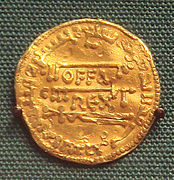 A mancus gold dinar of king Offa of Mercia, copied from the dinars of the Abbasid Caliphate (774); probably unintentionally, it still includes the Arabic text "Muhammad is the Apostle of God".
A mancus gold dinar of king Offa of Mercia, copied from the dinars of the Abbasid Caliphate (774); probably unintentionally, it still includes the Arabic text "Muhammad is the Apostle of God".
-
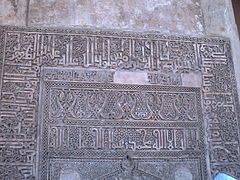 The Qibla of the Fatimid caliph al-Mustansir Billah in the Mosque of Ibn Tulun, Cairo showing the Shi'i shahada with the phrase ʿalī walī allāh at the end.
The Qibla of the Fatimid caliph al-Mustansir Billah in the Mosque of Ibn Tulun, Cairo showing the Shi'i shahada with the phrase ʿalī walī allāh at the end.
-
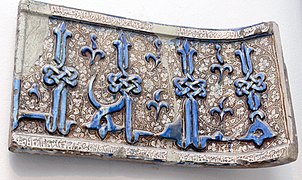 The first phrase of the Shahada in kufic calligraphy (1309), Kashan, Iran.
The first phrase of the Shahada in kufic calligraphy (1309), Kashan, Iran.
-
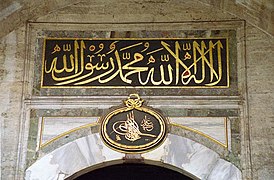 The Testimony of Faith inscribed as calligraphy on top of the Babussalam gate of the Topkapı Palace, Istanbul, Turkey.
The Testimony of Faith inscribed as calligraphy on top of the Babussalam gate of the Topkapı Palace, Istanbul, Turkey.
-
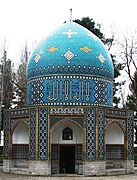 The Shi'i Shahada on the mausoleum of Attar of Nishapur, Iran. The first phrase is in white, the rest in blue.
The Shi'i Shahada on the mausoleum of Attar of Nishapur, Iran. The first phrase is in white, the rest in blue.
-
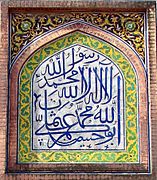 Tile panel in the Wazir Khan Mosque, Lahore, Pakistan. The Shahada is on the top half of the panel.
Tile panel in the Wazir Khan Mosque, Lahore, Pakistan. The Shahada is on the top half of the panel.
-
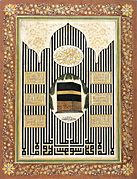 Shahadas written in the style of a Mamluk tughra on the bottom right and in mirror image on bottom left.
Shahadas written in the style of a Mamluk tughra on the bottom right and in mirror image on bottom left.
-
 The Shahada written in square Kufic script, shown as buildings topped with domes and minarets, with its mirror image on the left.
The Shahada written in square Kufic script, shown as buildings topped with domes and minarets, with its mirror image on the left.
-
 Shia Shahādah at Bab al-Futuh/Bab al-Nasr Fatimid Cairo with the phrase ʿalī walī allāh.
Shia Shahādah at Bab al-Futuh/Bab al-Nasr Fatimid Cairo with the phrase ʿalī walī allāh.
See also
- Aqidah
- Basmala
- Al Fātiḥah
- Six Kalimas
- Takbir
- Glossary of Islam
- List of Christian terms in Arabic
- Turkish national anthem (1921; the Shahadah is referenced in the eighth stanza)
Notes
- aš-šahādatān (الشَهادَتانْ Template:IPA-ar, "the two testimonials"); also Kalimat aš-šahādah [كلمة الشهادة Template:IPA-ar, "the testimonial word"
- The related noun šahīd (Template:IPA-ar شَهيد), which is used in the Quran mainly in the sense "witness", has paralleled in its development the Greek martys (Template:Lang-gr) in that it may mean both "witness" and "martyr". Similarly, šahāda may also mean "martyrdom" although in modern Arabic the more commonly used word for "martyrdom" is another derivative of the same root, istišhād (اسْتِشْهادْ).
References
Citations
- Malise Ruthven (January 2004). Historical Atlas of Islam. Harvard University Press. p. 14. ISBN 978-0-674-01385-8. Archived from the original on 25 September 2015. Retrieved 12 August 2015.
{{cite book}}: Unknown parameter|dead-url=ignored (|url-status=suggested) (help) - Richard C. Martín. Encyclopedia of Islam & the Muslim World. Granite Hill Publishers. p. 723. ISBN 978-0-02-865603-8.
- Frederick Mathewson Denny (2006). An Introduction to Islam. Pearson Prentice Hall. p. 409. ISBN 978-0-13-183563-4. Archived from the original on 5 August 2018. Retrieved 11 September 2017.
{{cite book}}: Unknown parameter|dead-url=ignored (|url-status=suggested) (help) - Mohammad, Noor (1985). "The Doctrine of Jihad: An Introduction". Journal of Law and Religion. 3 (2): 381–397. doi:10.2307/1051182. JSTOR 1051182.
- Wehr, Hans; J. Milton Cowan (1976). A Dictionary of Modern Written Arabic (PDF). pp. 488–489. Archived from the original (PDF) on 21 December 2015. Retrieved 26 November 2015.
{{cite book}}: Unknown parameter|dead-url=ignored (|url-status=suggested) (help) - David Cook, Martyrdom (Shahada) Oxford Bibliographies Archived 1 November 2015 at the Wayback Machine. ISBN 9780195390155.
- The Encyclopaedia of Islam, Volume IX, Klijkebrille, 1997, p. 201.
- John Wortabet; Harvey Porter (1 September 2003). English-Arabic and Arabic-English Dictionary. Asian Educational Services. p. 238. Archived from the original on 29 April 2016. Retrieved 26 November 2015.
{{cite book}}: Unknown parameter|dead-url=ignored (|url-status=suggested) (help) - ^ Cornell 2007, p. 8.
- ^ Lindsay 2005, p. 140–141.
- ^ Cornell 2007, p. 9.
- Michael Anthony Sells (1999). Approaching the Qur'an: The Early Revelations. White Cloud Press. p. 151.
- The Later Mughals by William Irvine p. 130
- Nasr et al (2015). The Study Quran. HarperOne. p. 110. (Footnote 255)
- Nasr et al (2015). The Study Quran. HarperOne. p. 1356. (Footnote 22)
- Edip Yuksel, et al (2007). Quran: A Reformist Translation. Brainbrow Press. Footnote 3:18.
- ^ Cornell 2007, p. 10.
- Lindsay 2005, p. 149.
- "Seeking the Straight Path: Reflections of a New Muslim". Archived from the original on 16 July 2007. Retrieved 9 July 2007.
{{cite web}}: Unknown parameter|dead-url=ignored (|url-status=suggested) (help) - Azim Nanji (2008). The Penguin Dictionary of Islam. Penguin UK. p. 101. Archived from the original on 23 April 2016. Retrieved 27 November 2015.
{{cite book}}: Unknown parameter|dead-url=ignored (|url-status=suggested) (help) - ^ Andrew Rippin (2005). Muslims: Their Religious Beliefs and Practices. Psychology Press. pp. 104–105. Archived from the original on 22 April 2016. Retrieved 27 November 2015.
{{cite book}}: Unknown parameter|dead-url=ignored (|url-status=suggested) (help) - ^ Ignác Goldziher (1981). Introduction to Islamic Theology and Law. Princeton University Press. pp. 18–19. Archived from the original on 22 April 2016. Retrieved 27 November 2015.
{{cite book}}: Unknown parameter|dead-url=ignored (|url-status=suggested) (help) - ^ Ian Richard Netton (19 December 2013). Encyclopaedia of Islam. p. 143. Archived from the original on 22 April 2016. Retrieved 27 November 2015.
{{cite book}}: Unknown parameter|dead-url=ignored (|url-status=suggested) (help) - Jonathan Holt Shannon (2006). Among the Jasmine Trees: Music and Modernity in Contemporary Syria. Wesleyan University Press. pp. 110–111. Archived from the original on 22 April 2016. Retrieved 27 November 2015.
{{cite book}}: Unknown parameter|dead-url=ignored (|url-status=suggested) (help) - Doris Behrens-Abouseif (1989). Islamic Architecture in Cairo: An Introduction. Brill. p. 54. Archived from the original on 22 April 2016. Retrieved 27 November 2015.
{{cite book}}: Unknown parameter|dead-url=ignored (|url-status=suggested) (help) - Oleg Grabar (ed.) (1985). An Annual on Islamic Art and Architecture. Brill. p. 110. Archived from the original on 22 April 2016. Retrieved 27 November 2015.
{{cite book}}:|author=has generic name (help); Unknown parameter|dead-url=ignored (|url-status=suggested) (help) - Eva Baer (2013). The Renaissance and the Ottoman World. Ashgate Publishing. pp. 41–43. Archived from the original on 22 April 2016. Retrieved 27 November 2015.
{{cite book}}: Unknown parameter|dead-url=ignored (|url-status=suggested) (help) - ^ Anna Contadini, Dr. Claire Norton (1989). Ayyubid Metalwork With Christian Images. Brill. p. 47.
- Graziella Parati (1999). Mediterranean Crossroads: Migration Literature in Italy. Fairleigh Dickinson Univ Press. p. 13.
- ^ Firefly Books (2003). Firefly Guide to Flags of the World. Firefly Books. ISBN 978-1-55297-813-9. Archived from the original on 18 June 2018. Retrieved 19 March 2018.
{{cite book}}: Invalid|ref=harv(help); Unknown parameter|dead-url=ignored (|url-status=suggested) (help) - "Saudi Arabia Flag and Description". World Atlas. Archived from the original on 22 June 2015. Retrieved 22 June 2015.
{{cite web}}: Unknown parameter|dead-url=ignored (|url-status=suggested) (help) - James B. Minahan. Encyclopedia of the Stateless Nations: Ethnic and National Groups Around the World A-Z. Greenwood Publishing Group. p. 806. ISBN 9780313076961.
- McCants, William (22 September 2015). "How ISIS Got Its Flag". The Atlantic. Archived from the original on 23 November 2015. Retrieved 23 November 2015.
{{cite news}}: Unknown parameter|dead-url=ignored (|url-status=suggested) (help)
Sources
- Cornell, Vincent J. (2007). Voices of Islam. Greenwood Publishing Group. p. 1400. ISBN 0275987337.
{{cite book}}: Invalid|ref=harv(help) - Lindsay, James E. (2005). Daily Life in the Medieval Islamic World. Greenwood Publishing Group. ISBN 9780313322709.
{{cite book}}: Invalid|ref=harv(help) - Arthur J. Magida. Opening the Doors of Wonder: Reflections on Religious Rites of Passage. University of California Press. ISBN 9780520941717.
External links
| Islam topics | |||||||||||||
|---|---|---|---|---|---|---|---|---|---|---|---|---|---|
| Outline of Islam | |||||||||||||
| |||||||||||||
| |||||||||||||
| |||||||||||||
| |||||||||||||

